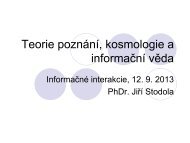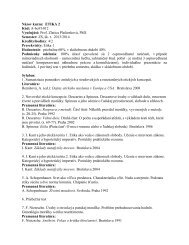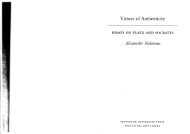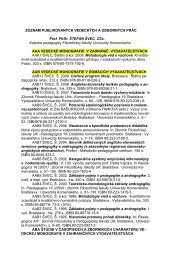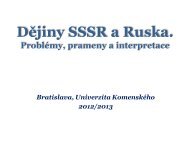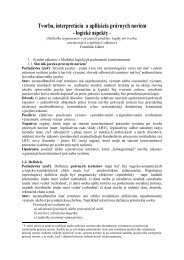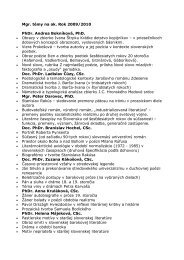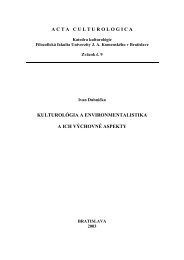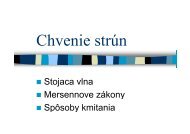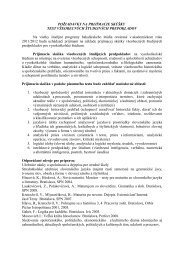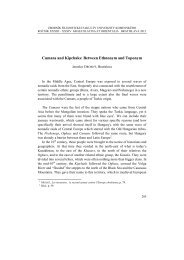You also want an ePaper? Increase the reach of your titles
YUMPU automatically turns print PDFs into web optimized ePapers that Google loves.
114 LEXICAL MEA l G<br />
food<br />
I =--=<br />
meat dairy product fruit vegetable<br />
~<br />
chee e bul/el' yogurt<br />
Cheddar feta Edam Gouda<br />
Figure 6.1 A partial taxonomy of food, particularlv chee e<br />
grain<br />
them), we refer to superordinate <strong>and</strong> subordinate categorie . So, we can ay<br />
that the word cheese i a hyperonym of the word cheddar <strong>and</strong> that the category<br />
CHEESE i uperordinatetothecategorYCHEDDAR. Wecanabbreviatethi with<br />
< <strong>and</strong> >: cheddar < cheese <strong>and</strong> cheese> cheddar. The ymbol alway points<br />
toward the smaller category. Figure 6.1 show that while one word may have<br />
several hyponym , each hyponym has only one immediate (i.e. on the next level<br />
up) hyperonym.<br />
A well as being asymmetrical the inclusion relation i. often aid to be transitive,<br />
which is to say that if X < Y <strong>and</strong> Y < Z, then X < Z. For example, cheddar<br />
is a type of cheese <strong>and</strong> chee e i a type of food, therefore cheddar i a type of<br />
food too. But this is where defining hyponymy get tricky, ince not all 'type-of'<br />
<strong>relations</strong> are tran itive, as (12) shows:<br />
(12) a.<br />
b.<br />
c.<br />
a peci men cup (as used for urine samples) is a type of cup<br />
a cup i a type of drinking ves el<br />
#!! a peci men cup i a type of drinking ves el<br />
The intransitivity of specimen cup < cup < drinking vessei tem from the fact<br />
that the 'type-of' <strong>relations</strong> in (12a) <strong>and</strong> (l2b) are not the ame. The relation<br />
in (l2a) involves proper inclusion; that is, the meaning cup is included in the<br />
meaning specimen cup - a cup i a container with a wide, round opening <strong>and</strong><br />
a low profile that can hold liquid , <strong>and</strong> a peci men cup i a particular kind of<br />
low container with a wide/round opening. On the other h<strong>and</strong>, (12b) i not proper<br />
inclusion - the meaning of cup doe not include the meaning of drinking vesse/instead<br />
a cup is an example of omething that can be u ed as a drinking ve sel.<br />
Cru e (1986) calls the proper-inclusion type of hyponymy taxonymy ( ince<br />
these are the <strong>relations</strong> found in cla ic taxonomies), while the ca e in (12b) can<br />
be called functionaJ hyponymy, ince we can say 'is used a ' rather than 'i a<br />
type of' in de cribing the relation. Beside functional hyponymy, there are other<br />
types of hyponymy that many would not con ider to be 'true' hyponymy. A<br />
Cruse (2000b) note , all queen are women, but iť a bit funny to aya queen<br />
is a type of woman (but le funny to say a queen is a type of monarch). In<br />
other words, we'd probably not li t queen in the same taxonomy in which we<br />
have the term woman, so queen < woman i not a taxonymic relation, while<br />
queen < monarch i . We can think of taxonyms as prototypical hyponyms,<br />
ince they are reliably tran i<br />
is a type of Y'<br />
The inclusion/taxonym relation<br />
ynonymy in light of the e tem<br />
Tran itive or intransitive? l yo<br />
near- ynonyms?<br />
Folk vs. scientift<br />
An important thing to notice<br />
valuable to u on an everyda<br />
hyperonym for cheese. In eve<br />
i a type of food bul in lhe '<br />
i a much-needed lexeme th.<br />
chee e belongs to <strong>and</strong> the Ol<br />
taxonorny that goe traight<br />
while in more specialist con<br />
with more fine-grained level<br />
ation , we are happy to say<br />
need to specify dog < cani<br />
tel' how many level a taxo:<br />
apply.<br />
Even among the smaller rn<br />
alient - i.e. more readily u I<br />
cheese example, notice that if<br />
to caJl it a cheese s<strong>and</strong>wich r;<br />
of cheddar, you would proba'<br />
have more specific informati<br />
caJl it cheese rather than CI/(<br />
general names in the e ituai<br />
a dairy-product s<strong>and</strong>wich. T<br />
that we generally attend to c<br />
Rosch (1978) <strong>and</strong> other h<br />
gui tie <strong>and</strong> cognitive term . li<br />
we notice <strong>and</strong> can easily dií<br />
tie level, the names for basi<br />
one morpheme rather than<br />
of the recognized propertie<br />
table 6.1.



